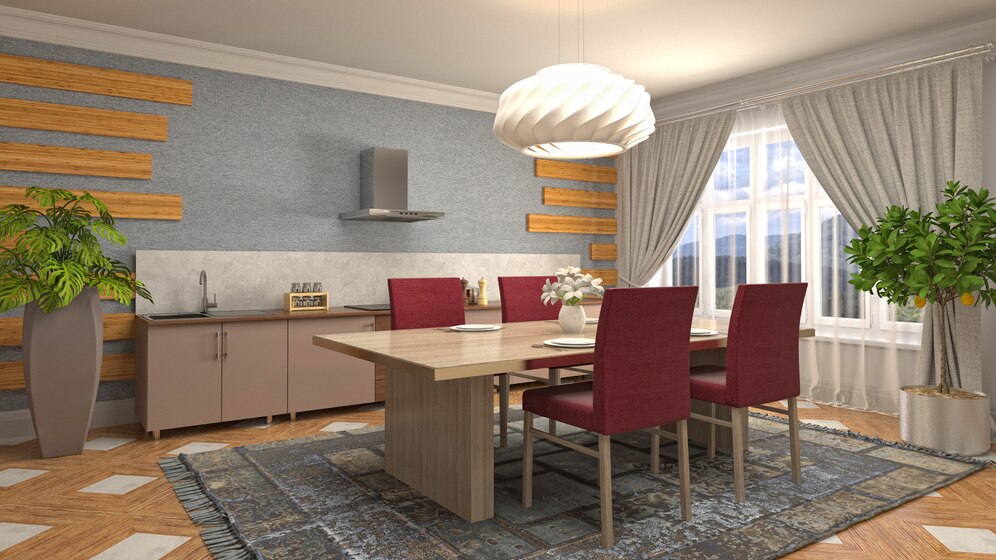The dining room once a central feature of the American home, is slowly vanishing from modern architectural designs. In past decades, it was the heart of formal gatherings, family meals, and celebrations. However, as lifestyles evolve and the need for efficient use of space grows, dining rooms are being phased out in favor of more versatile, open-concept layouts. This article delves into the Disappearing Dining Rooms in contemporary homes, the factors contributing to their decline, and what this trend means for how we live and interact within our homes.
The Evolution of the Dining Room
Dining rooms were traditionally reserved for special occasions—Thanksgiving dinners, holiday feasts, or Sunday family gatherings. They served as a formal space, often separated from the kitchen and living areas, designed for sit-down meals with family and guests.
In older homes, the dining room was a symbol of hospitality and status, showcasing elegant furniture and décor. It was a place where families gathered to connect over meals, away from distractions. However, in today’s fast-paced world, fewer families are sitting down for formal dinners. The dining room, once a vital part of the home, is now viewed by many as a luxury rather than a necessity Disappearing Dining Rooms.
From Essential to Expendable
As the way we live and eat has changed, the formal dining room has gradually become an expendable part of the home. With the rise of casual dining habits and the increasing demand for multi-functional living spaces, many families are opting for more flexible arrangements. The traditional walled-off dining room now gathers dust in many homes, used only during the occasional holiday meal.
Why Are Dining Rooms Disappearing?
1. Shift to Open-Concept Living
One of the biggest factors behind the disappearing dining room is the rise of open-concept living. Modern homeowners prefer open, flowing spaces that blend the kitchen, dining, and living areas into one seamless environment. The open floor plan promotes connectivity, allowing family members to interact while preparing meals, watching TV, or doing homework.
This shift reflects the way people live today—less formality, more casual interactions. Open kitchens with islands or breakfast bars often replace the need for a separate dining room, serving both as cooking spaces and dining areas. The result is a more flexible, informal setup that suits the modern lifestyle.
2. Smaller Homes and Apartments
As urbanization increases and housing prices rise, many people are opting for smaller homes and apartments. In these spaces, every square foot counts, and there is little room for formal, dedicated dining areas. Developers and architects focus on maximizing living areas and bedrooms, leaving dining rooms out of the equation.
In many city apartments, dining is now relegated to kitchen counters, small tables in living rooms, or even couches and beds. The lack of a dining space may not be a consumer preference, but rather a response to space limitations driven by the housing market and economic pressures.
3. Changing Dining Habits
The way we eat has also contributed to the decline of the dining room. The traditional family meal at a set time is less common in today’s world of busy schedules, where people eat on the go or at different times. Families no longer rely on dining rooms for daily meals, instead opting for more convenient locations such as the kitchen counter, coffee table, or even in front of the television.
The rise of fast food, meal delivery services, and grab-and-go dining options has reduced the need for a formal dining space. Many people now prefer quick, informal meals over the ritual of sitting down in a dedicated dining room.
The Impact of the Disappearing Dining Room
1. Loss of a Gathering Space
The loss of the dining room represents more than just a change in home design—it reflects a shift in the way we interact with our families and guests. Dining rooms were traditionally a place for gathering, connecting, and creating memories. With their disappearance, families may miss out on the bonding experience of sitting down together for a meal.
In smaller apartments where even a table and chairs may be absent, hosting a meal can become virtually impossible. This can contribute to a sense of isolation, as shared meals are an important aspect of social interaction and community building.
2. Designing Loneliness into Homes
There is growing concern that the absence of dining rooms, and the shrinking of communal spaces in general, is contributing to a sense of loneliness in modern homes. As more people eat alone or in front of screens, they may miss out on the human connection that comes from sharing meals with others.
Architects and developers are increasingly designing homes for efficiency and affordability, often at the expense of spaces that foster connection and community. While open-concept living can promote interaction, the lack of a formal dining area may lead to fewer shared experiences.
3. The Rise of Multi-Functional Spaces
In response to the disappearing dining room, many homes now feature multi-functional spaces that can be adapted to different uses. Kitchen islands and breakfast nooks serve as informal dining areas, while living rooms double as places for eating, entertaining, and relaxing.
Furniture designers are also creating pieces that can easily transform from dining tables to workspaces or entertainment centers, reflecting the need for versatility in today’s homes. While the dining room may be disappearing, multi-functional spaces are filling the gap, allowing homeowners to make the most of their square footage.
The Future of Dining Rooms
As the trend of Disappearing Dining Rooms continues, it’s worth asking whether they will ever make a comeback. While the traditional, walled-off dining room may be a thing of the past, there is still a desire for spaces that bring people together for meals and socializing.
1. Flexible Dining Spaces
In the future, dining rooms may take on a more flexible form, blending with other areas of the home while still providing a dedicated space for meals. For example, dining tables that can be folded away when not in use, or dining areas that double as workspaces or study areas, may become more common in modern homes.
2. Outdoor Dining Areas
As outdoor living becomes more popular, many homeowners are creating dining spaces outside, taking advantage of patios, decks, and balconies. Outdoor dining areas offer a casual, relaxed setting for meals, allowing families to enjoy the outdoors while eating together.
3. A Return to Tradition?
While the dining room may be disappearing in many homes, there is a chance that it could make a return as people seek to create spaces for connection and community. As more people recognize the value of shared meals and the importance of family time, dining rooms could become a sought-after feature in future homes.
Adapting to the New Normal: How to Create Dining Spaces in Smaller Homes
For those living in smaller homes or apartments, creating a functional dining space can be a challenge. However, there are creative solutions to ensure that meals can still be shared, even in compact spaces.
1. Make Use of Multi-Functional Furniture
In small spaces, every piece of furniture should serve more than one purpose. Opt for dining tables that can fold down when not in use, or kitchen islands that can double as dining areas. Look for furniture with built-in storage to keep your space organized and clutter-free.
2. Create a Dining Nook
Even if you don’t have room for a traditional dining room, you can create a cozy dining nook in a corner of your living room or kitchen. Use a small table and chairs, or opt for a bench to save space. Adding cushions and décor can make the nook feel inviting and comfortable for meals.
3. Use Outdoor Spaces
If you have access to a balcony, patio, or backyard, consider creating an outdoor dining area. A small table and chairs, along with some plants and lighting, can transform your outdoor space into a charming spot for meals and gatherings.
Conclusion
The Disappearing Dining Rooms reflects the broader changes in how we live, eat, and interact with one another. While the traditional dining room may no longer be a staple in modern homes, its loss doesn’t necessarily mean the end of shared meals and connection.
As homes continue to evolve, the need for versatile, multi-functional spaces will become even more important. Whether through open-concept living, outdoor dining areas, or creative furniture solutions, families can still find ways to gather and enjoy meals together, even in the absence of a formal dining room.







